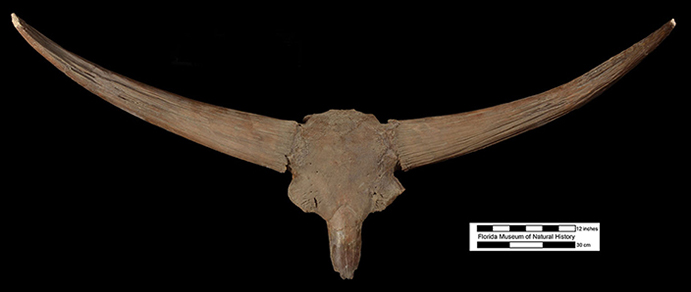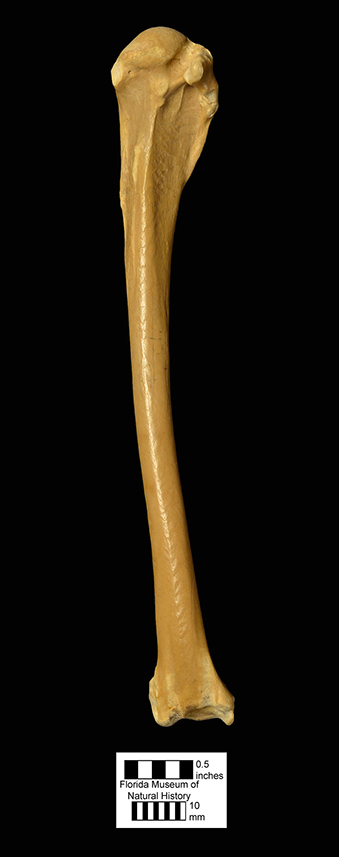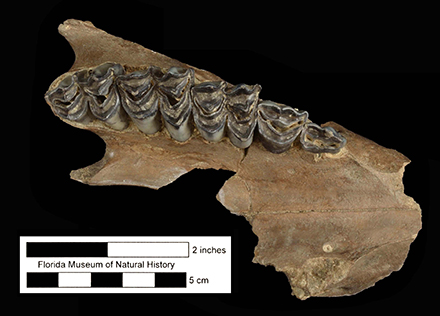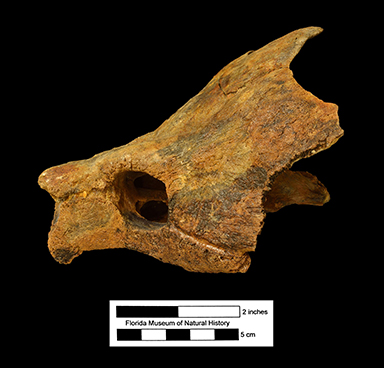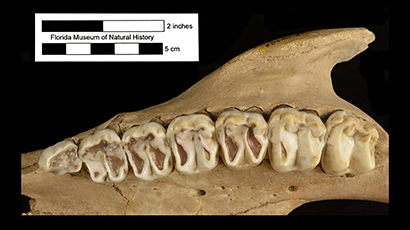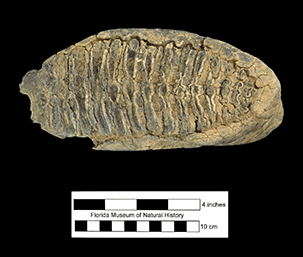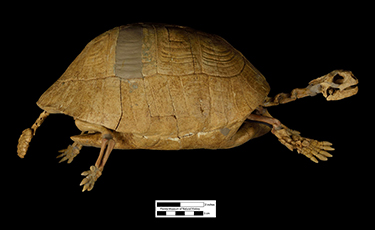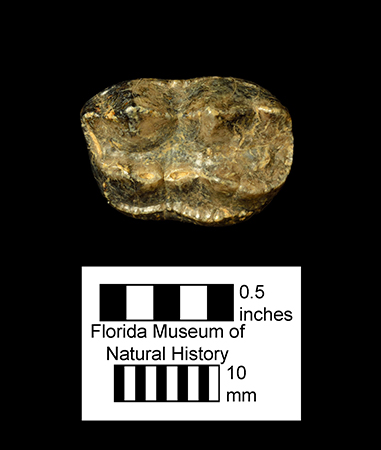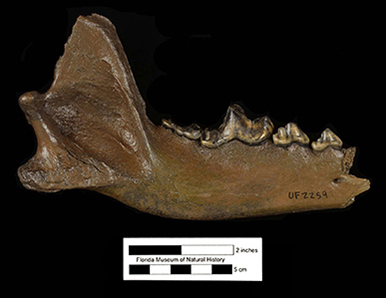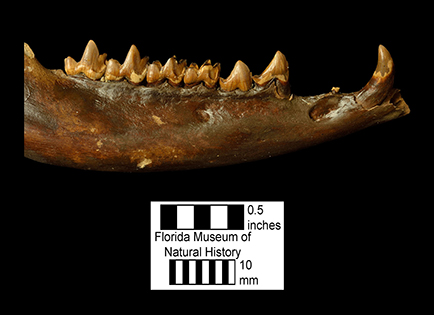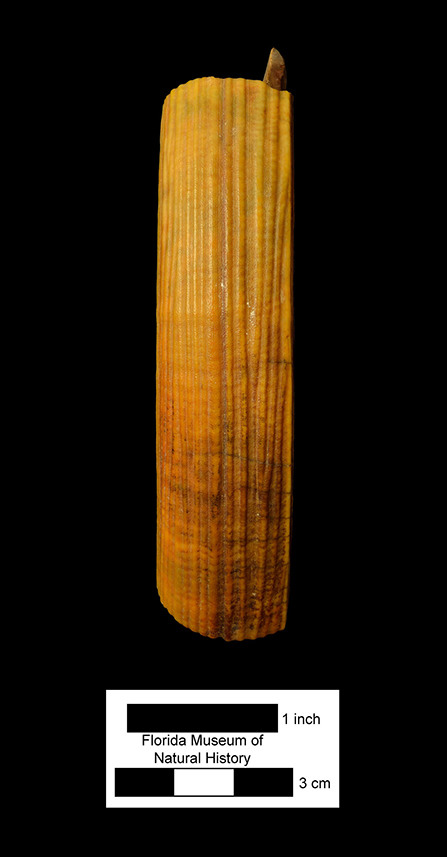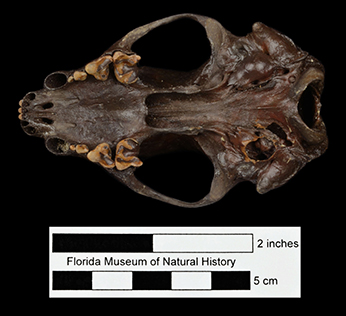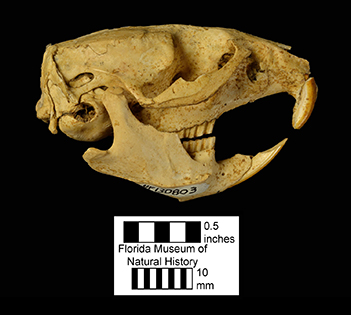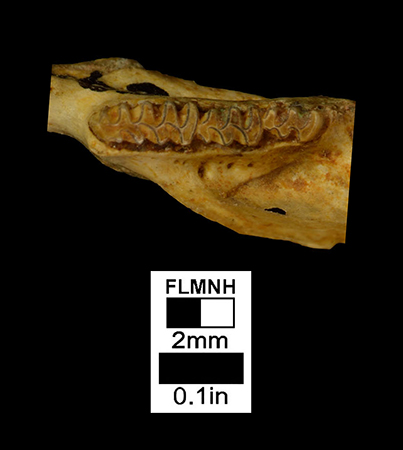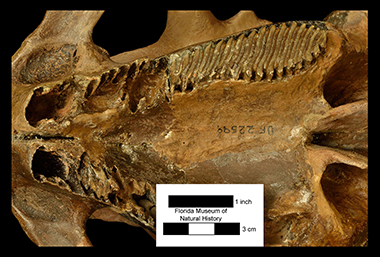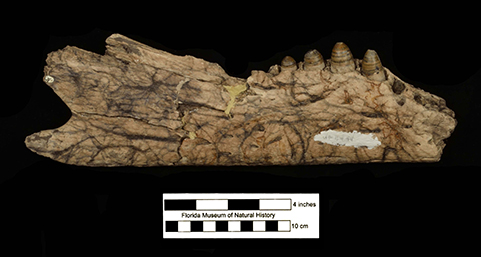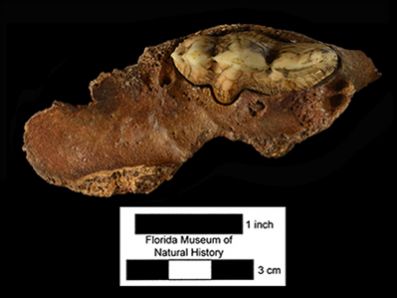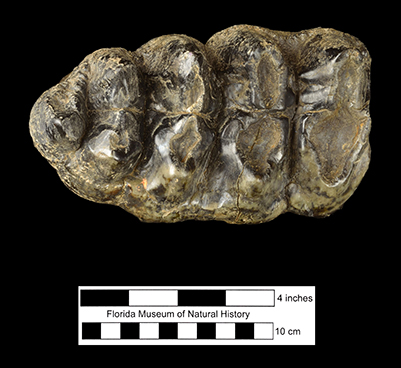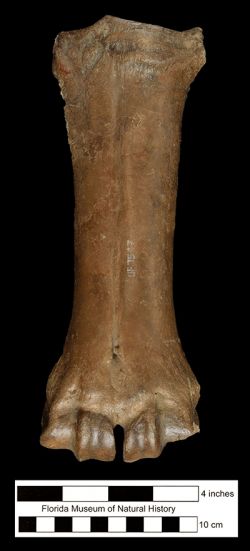
Defining taxon: first appearance of Bison south of 55° N latitude (Bell et al., 2004)
Basis of name: Rancho la Brea tar pits, Los Angeles, California
The Rancholabrean NALMA is represented by several thousand individual vertebrate fossil sites distributed from Alaska to Central America. There are over 500 Rancholabrean sites in Florida alone (Table 1). The Rancholabrean is divided into two subintervals, the Ra1, from 250,000 to 115,000 years ago; and the Ra2, from 115,000 to 12,000 years ago.
Index species for the Ra1 in Florida: Henocitta brodkorbi, Microtus hibbardi, and Sigmodon bakeri
Significant Ra1 localities and faunas in Florida: Haile 7A; Williston 3A; Rock Springs; Oldsmar 1; Wilson Quarry; Dickerson Coquina Pit; Daytona Beach Bone Bed
Index species for the Ra2 in Florida: Gymnogyps californianus, Megalonyx jeffersoni, Castor canadensis, Microtus pinetorum, Peromyscus gossypinus, Sigmodon hispidus, Canis latrans, Ursus americanus, Mephitis mephitis, Panthera atrox, Puma concolor, and Bison antiquus. Humans and the domestic dog (Canis lupus familiaris) first appear very late in the Ra2, an event that has recently been made the basis for a new LMA, the Santarosean (Barnosky et al., 2014).
Significant Ra2 localities and faunas in Florida: Arredondo; Haile (numerous localities); Hornsby Springs; Surprise Cave; Melbourne; Lecanto 3A; Sabertooth Cave; Ichetucknee River; Santa Fe River (in part); Cutler Hammock; Monkey Jungle Hammock 1; Peace River (in part); Vero Canal Site; Devil’s Den; Withlacoochee River (in part); Steinhatchee River; Wekiva River; West Palm Beach Site; Bradenton Field; Bradenton 51st Street; Rainbow River; Reddick 1A, 1B, and 1C; Millennium Park; Seminole Field; Warm Mineral Springs; Aucilla River (numerous localities); Wakulla Springs; Chipola River
Characteristic species for the Rancholabrean in Florida: Hesperotestudo crassiscutata, Hesperotestudo incisa, Trachemys scripta, Alligator mississippiensis, Cygnus columbianus, Podiceps auritus, Meleagris gallopavo, Colinus virginianus, Haliaeetus leucocephalus, Holmesina septentrionalis, Glyptotherium floridanum, Paramylodon harlani, Eremotherium laurillardi, Castoroides dilophidus, Oryzomys palustris, Neofiber alleni, Synaptomys australis, Neochoerus pinckneyi, Sylvilagus floridanus, Sylvilagus palustris, Canis dirus, Urocyon cinereoargenteus, Tremarctos floridanus, Panthera onca, Smilodon fatalis, Mammut americanum, Mammuthus columbi, Equus ferus fraternus, Tapirus veroensis, Palaeolama mirifica, Bison latifrons, Mylohyus fossilis, and Platygonus compressus.
Gallery of Rancholabrean Fossils from Florida
Major extinctions: There is a well-known mass extinction event at the end of the Rancholabrean. It mostly effected large mammals across the entire continent, but small mammals, amphibians, reptiles, and birds also became extinct at this time. The cause(s) of this extinction event have been the center of a long and sometimes colorful debate within the scientific community. The two major competing hypotheses are rapid climate change and human hunting, although an asteroid/comet impact and exotic diseases have their proponents.
The following genera of large mammals known from Florida and their constituent species became extinct during or at the end of the late Pleistocene: Holmesina, Glyptotherium, Paramylodon, Eremotherium, Megalonyx, Castoroides, Neochoerus, Arctodus, Homotherium, Smilodon, Miracinonyx, Mylohyus, Platygonus, Hemiauchenia, Palaeolama, Mammut, Cuvieronius, and Mammuthus. Extinction at the species level occurred for Canis dirus, Tremarctos floridanus, Panthera atrox, Leopardus amnicola, Bison latifrons, and Tapirus veroensis. The indigenous subspecies of the horse Equus also became extinct.
The following small mammals known from Florida fossils became extinct during or at the end of the late Rancholabrean: the dwarf rabbit Sylvilagus palustrellus, the chipmunk Tamias aristus, the bog lemming Synaptomys australis, the pocket gopher Thomomys orientalis, the mustached bat Pteronotus pistinus, and the vampire bat Desmodus stocki.
The following amphibians and reptiles known from Florida fossils became extinct during or at the end of the late Rancholabrean: the dwarf siren Pseudobranchus robustus, the map turtle Graptemys kerneri, the giant box turtle Terrapene putnami, giant tortoise Hesperotestudo crassiscutata, and small tortoise Hesperotestudo incisa.
The following birds known from Florida fossils became extinct during or at the end of the late Rancholabrean: the duck Anas itchtucknee, the stork Ciconia maltha, the quail Neortyx peninsularis, the grebes Podiceps dixi and Podilymbus wetmorei, the anhinga Anhinga beckeri, the teratorn Teratornis merriami, the eagle Amplibuteo woodwardi, the hawk-eagle Spizaetus grinnelli, and the cowbird Pandanaris convexa.
There were also numerous species that disappeared from Florida at or near the end of the Rancholabrean, but survived elsewhere (with some even re-entering the region at a later date). Examples of these include the jaguar Panthera onca, the panther Puma concolor, the ocelot Leopardus pardalis, the jackrabbit Lepus sp., the ground squirrel Spermophilus sp., the muskrat Ondatra zibethicus, the porcupine Erethizon dorsatum, the bonneted bat Eumops underwoodi, hog-nosed skunk Conepatus leuconotus, the trumpeter swan Cygnus buccinator, the heath hen Tympanuchus cupido, the ruffed grouse Bonasa umbellus, the Manx shearwater Puffinus puffinus, the northern jacana Jacana spinosa, and the condor Gymnogyps californianus.
Comments: Florida has over 500 Rancholabrean vertebrate fossils sites that range across the state (Table 1). Because sea level was uniformly lower than what it is today through the late Rancholabrean (Ra2), often greatly so, there are no marine sites from this interval in Florida. Some Florida Ra2 sites do contain marine fossils, but these are reworked from older deposits. Most Ra2 vertebrate fossils found in Florida come from four types of localities:
1. From the beds and banks of many rivers and spring runs.
2. From sediments filling caves and sinkholes.
3. From stream, lake, and marsh deposits found in coastal regions on both the Atlantic and Gulf sides of the peninsula..
4. From beaches in both the Amelia Island-Jacksonville-St. Augustine area on the Atlantic coast and from Clearwater south to Venice on the Gulf side. These are usually specimens eroded out of off-shore deposits during storms or excavated during dredging, and then washed up on the modern beach.
The early Rancholabrean (Ra1) interval includes two major interglacial periods, corresponding to Marine Isotope Stages (MIS) 5 and 7 at around 125 and 225 thousand year ago. Sea level was higher than present during some portions of MIS 5, producing marine deposits that are currently above or at modern sea level along the Atlantic coast of Florida. These contain some marine vertebrate fossils. Examples of these include the Wilson Quarry, Dickerson Coquina Pit and the Daytona Beach Bone Bed.
The presence of Bison at a Florida fossil site is a clear indicator of a Rancholabrean age. Bison are fairly common, and found at most Rancholabrean sites that produce large mammals. TBut absence of Bison is by itself not definitive evidence of that a site is not Rancholabrean, as this could be the result of taphonomic or ecologic factors, or simply chance if there not many specimens. Another possible cause of confusion is bones and teeth of domestic cattle, which can be misidentified as fossils of Bison unless careful comparisons are made.
It is not always easy to determine if a Florida site or locality belongs in the Ra1 or the Ra2, particularly if the number of species is relatively low and/or preservation is poor such that species-level identifications cannot be made for many taxa. Formerly, it was thought that Bison latifrons was limited to the Ra1 and Bison antiquus to the Ra2 (Robertson, 1974; Morgan and Hulbert, 1995, Hulbert, 2001). But it is now known that Bison latifrons persisted into the late Ra2 in the southeastern United States (Patterson et al., 2012), so its presence cannot distinguish between the two. This accounts for reassigning Haile 8A and the Bradenton sites to the younger, Ra2 age (formerly Ra1 in Morgan and Hulbert, 1995; Hulbert, 2001). Bison antiquus does still appear to be limited to the Ra2. Ra1 faunas can be recognized by the presence of the extinct rodent species Microtus hibbardi and Sigmodon bakeri, instead of Microtus pinetorum and Sigmodon hispidus that are found in Ra2 and Holocene faunas. But the differences between these species are subtle and require detailed study to identify correctly. If these species are lacking, Ra1 vertebrate faunas in Florida are usually recognized if they are found associated with or stratigraphically below MIS 5 or MIS 7 marine deposits.
Table 1. Number of Pleistocene vertebrate fossils sites known from counties in Florida, subdivided by land mammal age.
| Rancholabrean | Irvingtonian | Blancan | |
| ALACHUA |
72 |
5 |
5 |
| BREVARD |
9 |
4 |
0 |
| BROWARD |
1 |
0 |
0 |
| CHARLOTTE |
3 |
8 |
16 |
| CITRUS |
18 |
1 |
16 |
| COLLIER |
0 |
1 |
1 |
| COLUMBIA |
60 |
0 |
12 |
| DADE |
3 |
0 |
0 |
| DE SOTO |
17 |
1 |
8 |
| DIXIE |
8 |
0 |
0 |
| DUVAL |
3 |
0 |
0 |
| FLAGLER |
5 |
0 |
0 |
| GILCHRIST |
6 |
1 |
1 |
| GLADES |
3 |
0 |
1 |
| HARDEE |
21 |
1 |
0 |
| HENDRY |
5 |
4 |
4 |
| HERNANDO |
1 |
0 |
0 |
| HIGHLANDS |
0 |
0 |
1 |
| HILLSBOROUGH |
7 |
15 |
0 |
| INDIAN RIVER |
6 |
0 |
0 |
| JACKSON |
7 |
0 |
0 |
| JEFFERSON |
11 |
0 |
0 |
| LAFAYETTE |
3 |
1 |
0 |
| LAKE |
3 |
0 |
0 |
| LEE |
2 |
0 |
2 |
| LEON |
0 |
0 |
1 |
| LEVY |
45 |
1 |
2 |
| LIBERTY |
0 |
0 |
1 |
| MADISON |
1 |
0 |
1 |
| MANATEE |
9 |
1 |
0 |
| MARION |
59 |
0 |
2 |
| MARTIN |
2 |
0 |
0 |
| NASSAU |
3 |
0 |
0 |
| OKEECHOBEE |
0 |
0 |
1 |
| ORANGE |
1 |
1 |
0 |
| PALM BEACH |
2 |
3 |
0 |
| PINELLAS |
19 |
0 |
1 |
| POLK |
5 |
20 |
0 |
| PUTNAM |
9 |
0 |
3 |
| SARASOTA |
16 |
3 |
19 |
| SEMINOLE |
5 |
0 |
0 |
| ST. JOHNS |
4 |
0 |
0 |
| ST. LUCIE |
3 |
0 |
0 |
| SUMTER |
6 |
1 |
1 |
| SUWANNEE |
12 |
0 |
1 |
| TAYLOR |
31 |
0 |
0 |
| VOLUSIA |
6 |
0 |
0 |
| WAKULLA |
10 |
0 |
0 |
| WALTON |
1 |
0 |
0 |
| total |
523 |
72 |
100 |
Sources
- Author: Richard C. Hulbert Jr.
- Image Gallery: Natali Valdes
- Original Publication Date: June 18, 2015
- Last Updated On: July 2, 2015
References
Barnosky, A. D., et al. 2014. Prelude to the Anthropocene: Two new North American land mammal ages (NALMAs). Anthropocene Review 1(3):225-242. DOI: 10.1177/2053019614547433.
Bell, C. J., E. L. Lundelius Jr, A. D. Barnosky, R. W.Graham, E. H. Lindsay, D. R. Ruez Jr., H. A. Semken Jr., S. D. Webb, and R. J. Zakrzewski. 2004. The Blancan, Irvingtonian, and Rancholabrean mammal ages. Pp. 232–314 in M. O. Woodburne (ed.), Late Cretaceous and Cenozoic Mammals of North America. Columbia University Press New York.
Hulbert Jr., R. C. (ed.) 2001. The Fossil Vertebrates of Florida. University Press of Florida: Gainesville.
Morgan, G. S. and R. C. Hulbert, Jr. 1995. Overview of the geology and vertebrate biochronology of the Leisey Shell Pit local fauna, Hillsborough County, Florida. Bulletin of the Florida Museum of Natural History 37:1-92.
Patterson, D. B., A. J. Mead, and R. A. Bahn. 2012. New skeletal remains of Mammuthus columbi from Glynn County, Georgia with notes on their historical and paleoecological significance. Southeastern Naturalist 11(2):163-172
Robertson, J. S. 1974. Fossil Bison of Florida. Pp. 214–246 in S. D. Webb (ed.), Pleistocene Mammals of Florida. University Presses of Florida, Gainesville.
Webb, S. D. 1974. Chronology of Florida Pleistocene mammals. Pp. 5-31 in S. D. Webb (ed.), Pleistocene Mammals of Florida. University of Florida Press, Gainesville.
